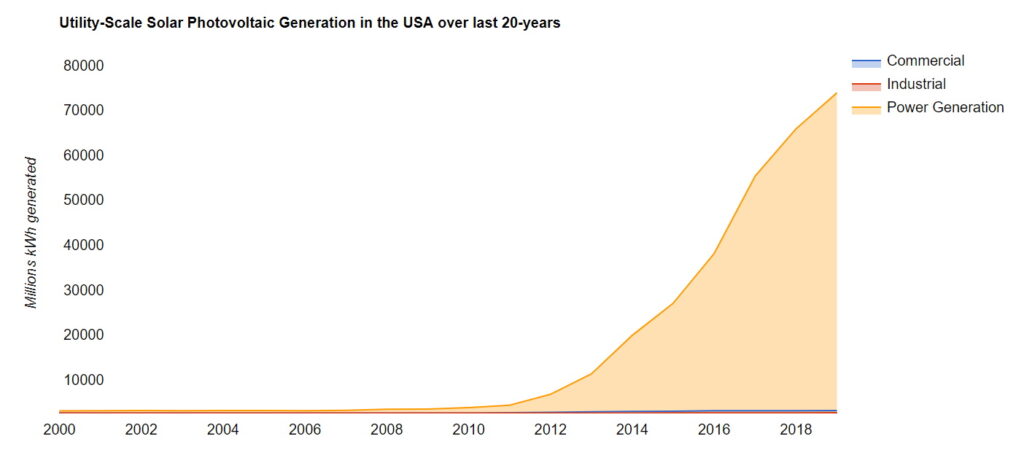The Exponential Growth of Photovoltaic Electricity Generation
Photovoltaic electricity generation expected to account for 18% of USA total by 2050
Solar panel costs have been in constant decline over the last decade. Prompting the question: When can we expect photovoltaic electricity generation to supersede existing, higher emission, generation sources?
When it comes to photovoltaic projects there are two types: Distributed Generation and Utility-scale Generation. The first (Behind the Meter) are systems that are paired with the energy load of a facility, directly supplying it with power. The latter, Utility-scale generation (In-front of the meter) is for larger capacity systems that generate electricity for the grid.
Over the last 20-years capacities of solar installations have exponentially risen across the USA, owed to:
- Stringent environmental regulations on carbon emissions
- Reduced costs of photovoltaic technology
- Tax credits and incentives offered for solar implementations
- Shift towards sustainable off-grid power alternatives
Historical data published by the US Energy Information Administration indicates that over the course of the last 20-years there has been a 300x growth in photovoltaic capacities for the Distributed Generation setting. Notably in residential, commercial and industrial sectors where on-site generation reduces electricity bills and provides energy storage opportunities.

Similarly, Utility-scale generation has seen a 150x increase in capacity over the last 20-years in the US. This is attributed to the continuing decline in capital costs for renewable energy technology and mandates for renewable energy, such as RECs. This paves the way for connected community projects where small-scale solar farms can be generate domestic electricity and feed back to the grid.

As electricity demand continues to grow, generation will primarily be driven by renewable sources and natural gas. It is expected that less-efficient fossil fuel power plants will soon be retired due to emission regulations and economic viability, coupled with an increase in renewable energy tax credits, this will lead to around 36% of the electricity generated in the USA by 2050 to come from renewable energy sources. This future profile however is sensitive to the price of natural gas and predicted growth in electricity demand.
Solar projects to contribute 46% of renewable electricity generation, followed by wind (33%), hydroelectric (14%) and geothermal (3%).

Increased solar adoption is great news! We can generate clean electricity with no negative carbon effects at a lower cost and reduce strain on the grid infrastructure. With mass adoption however the idea of photovoltaic system efficiencies becomes important. A typical photovoltaic panel will have an electrical efficiency between 18 – 22%, with the rest being in the form of solar heat which is wasted; at such large scale of adoption that heat can amount to millions of joules per year.
Up and coming technologies such as photovoltaic-thermal panels can harness both electricity and heat from the sun, bringing the panel efficiency up to 90%. With reduced capital costs over time, these panels are expected to outperform standard photovoltaic panels. By providing more value to end-users and the opportunity to further adopt trigeneration units, solar energy can drive electricity, heating and cooling by 2050.


